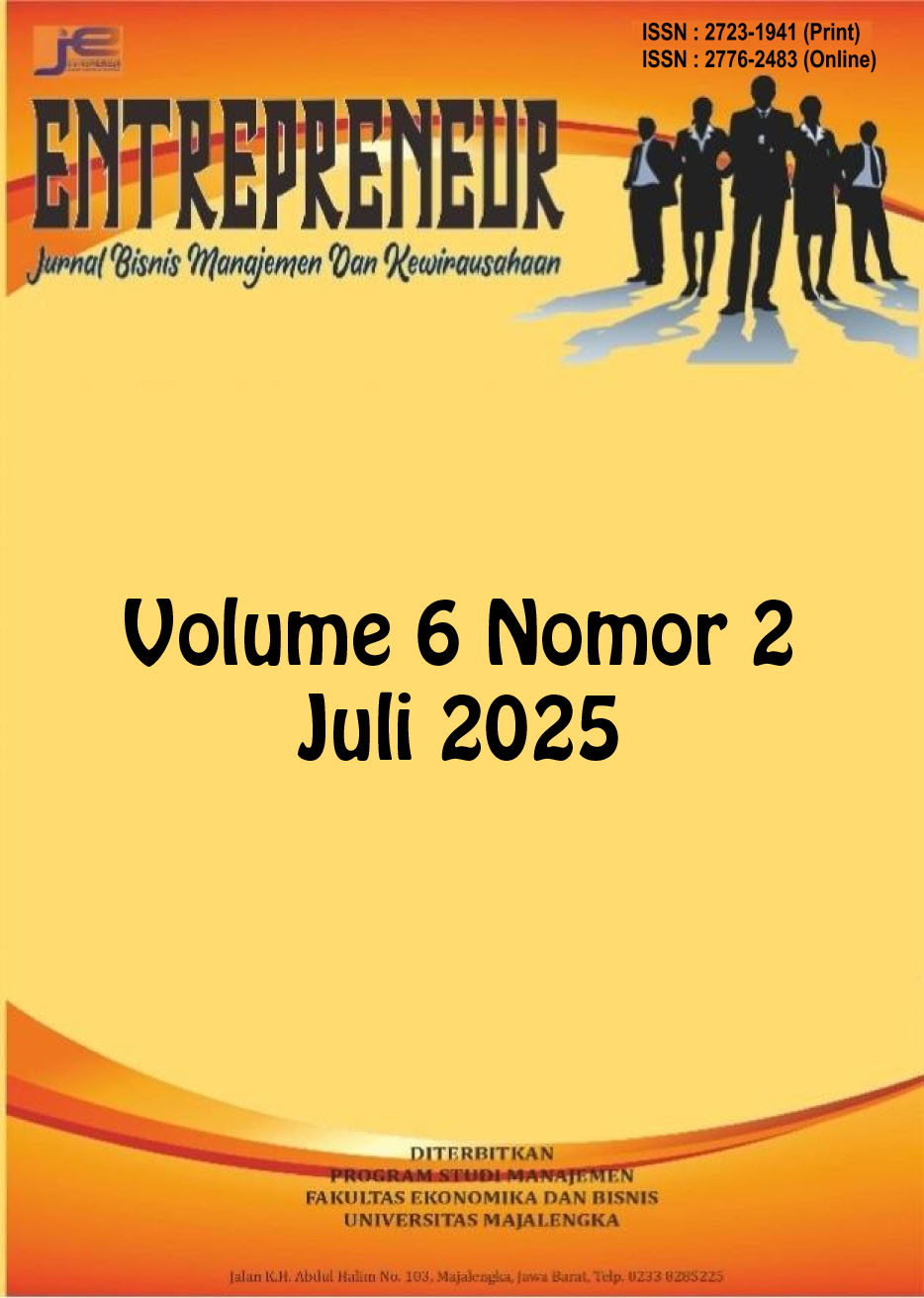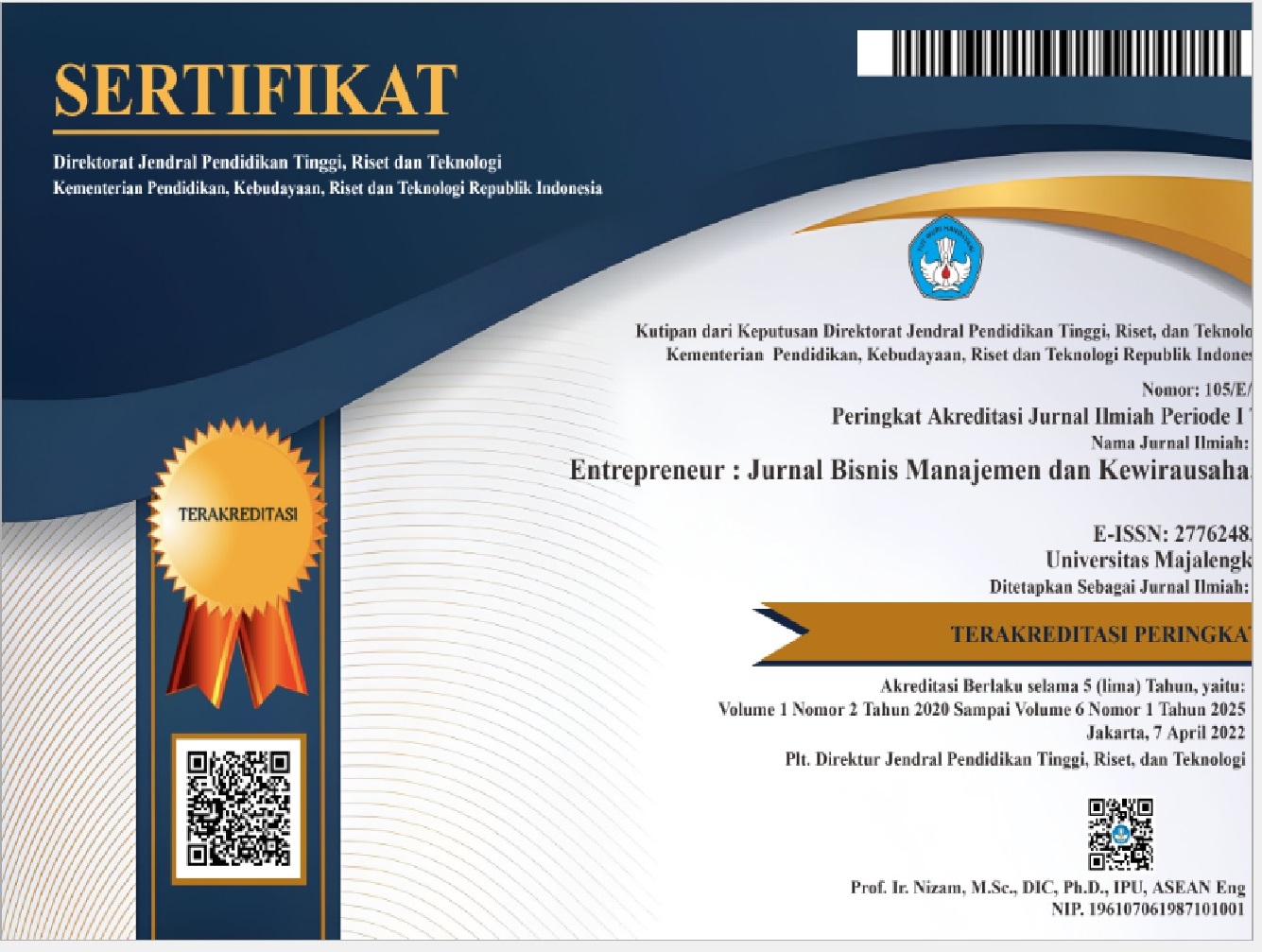Pembangunan RS Putra Medika Bekasi: Analisis TOWS dengan Pendekatan Mixed Methods Eksploratif
DOI:
https://doi.org/10.31949/entrepreneur.v6i2.14048Abstract
ospital expansion is driven by demand for health services due to the uneven health facilities in Bekasi Regency. This study aims to analyse the development strategy of Putra Medika Hospital using TOWS Analysis and Exploratory Mixed Methods. This research method is mixed. The qualitative phase began with in-depth interviews with the management of the Putra Medika Group Clinic to identify strengths, weaknesses, opportunities and threats. This qualitative data became the foundation for formulating the TOWS matrix. Then, the quantitative phase in the form of a survey was conducted on prospective patients and stakeholders, validating the qualitative findings and measuring market preferences. The qualitative participants were 22 people while the quantitative sample was 40 people. The results of the TOWS analysis show that Putra Medika has internal strengths to capitalise on market opportunities, but also needs to overcome weaknesses and manage competitor threats. In conclusion, Putra Medika Clinic management must integrate the findings of internal and external factors to produce concrete strategic recommendations for hospital development. These include optimisation of superior services, effective marketing strategies, and risk mitigation. The implications of this research offer practical guidance for Putra Medika's management so that expansion in Bekasi can be carried out in a sustainable and competitive manner.
Keywords:
Competitive Advantage, Marketing Strategy, SWOT AnalysisDownloads
References
Aini, S. N. (2024). Analisis Makroekonomi dari Pembangunan Infrastruktur dengan Skema Public--Private Partnership (PPP) di Asean. Universitas Islam Indonesia.
Aslan, I., Çinar, O., & Özen, Ü. (2014). Developing strategies for the future of healthcare in Turkey by benchmarking and SWOT analysis. Procedia-Social and Behavioral Sciences, 150, 230–240.
Charles, J. M., Brown, G., Thomas, K., Johnstone, F., Vandenblink, V., Pethers, B., Jones, A., & Edwards, R. T. (2016). Use of programme budgeting and marginal analysis as a framework for resource reallocation in respiratory care in North Wales, UK. Journal of Public Health (United Kingdom), 38(3), e352–e361. https://doi.org/10.1093/pubmed/fdv128
Charli, M. S., Eshete, S. K., & Debela, K. L. (2022). Learning How Research Design Methods Work: A Review of Creswell’s Research Design: Qualitative, Quantitative and Mixed Methods Approaches. The Qualitative Report, 27(12), 2956–2960. https://doi.org/10.46743/2160-3715/2022.5901
Dickson, V. V., & Page, S. D. (2021). Using mixed methods in cardiovascular nursing research: Answering the why, the how, and the what’s next. European Journal of Cardiovascular Nursing, 20(1), 82–89. https://doi.org/10.1093/eurjcn/zvaa024
Haynes, A., Howard, K., Johnson, L., Williams, G., Clanchy, K., Tweedy, S., Scheinberg, A., Chagpar, S., Wang, B., Vassallo, G., Ashpole, R., Sherrington, C., & Hassett, L. (2023). Physical Activity Preferences of People Living with Brain Injury: Formative Qualitative Research to Develop a Discrete Choice Experiment. Patient, 16(4), 385–398. https://doi.org/10.1007/s40271-023-00628-9
Indrawati, I. D., & Yuttama, F. R. (2025). Analisis studi kelayakan bisnis ditinjau dari aspek pemasaran dan aspek keuangan pada umkm frutty tutty purwokerto. Jurnal Enttrepreneurrepreneur, 06(01), 124–133.
Jordan, J., Berger, M., Curato, M., Ilgen, J. S., Hopson, L. R., Clarke, S. O., Chipman, A. K., Janicki, A., & Gottlieb, M. (2022). “Not just a checkbox”: A qualitative study of the resident scholarly experience. AEM Education and Training, 6(6). https://doi.org/10.1002/aet2.10824
Liliweri, Y. K. N., Mandaru, S. S. E., & Daga, L. L. (2020). Strategi Perancangan Komunikasi Visual Promosi Karya Seni Ukir Kayu Motif Khas Timor. Jurnal Communio : Jurnal Jurusan Ilmu Komunikasi, 9(1), 1564–1580. https://doi.org/10.35508/jikom.v9i1.2385
Limaku, M. (2019). Analisis swot dalam menetapkan strategi menjalankan BPJS Kesehatan pada mitra keluarga Kalideres. Jurnal Manajemen Bisnis Dan Kewirausahaan, 3(5), 62–66.
Peters, M., & Fàbregues, S. (2023). Missed opportunities in mixed methods EdTech research? Visual joint display development as an analytical strategy for achieving integration in mixed methods studies. Educational Technology Research and Development, 72(5), 2477–2497. https://doi.org/10.1007/s11423-023-10234-z
Prasetya, D. A. (2023). Teknik Analisis SWOT: Panduan Praktis Mengubah Tantangan Menjadi Peluang Untuk Strategi Bisnis Anda. Anak Hebat Indonesia.
Rahmani, N., Roshan, F. S. S. N., Nabavian, M., & Alipour, H. (2023). The design and psychometric evaluation of a COVID-19 social stigma questionnaire in nurses. BMC Nursing, 22(1), 1–10. https://doi.org/10.1186/s12912-023-01620-2
Rana, K., Poudel, P., & Chimoriya, R. (2023). Qualitative Methodology in Translational Health Research: Current Practices and Future Directions. Healthcare (Switzerland), 11(19), 1–16. https://doi.org/10.3390/healthcare11192665
Rao, Y. S. (2017). C5 model for the consortium management: SWOT analysis. Library Management, 38(4/5), 248–262.
Salamah, U. (2010). Pengaruh Diversifikasi Layanan Rumah Sakit dan Koordinasi antar Unit dan Antar Profesi Terhadap Kinerja Layanan Kesehatan dalam Peningkatan Kepuasan Pasien dan Optimalisasi Sarana Layanan Kesehatan di Kabupaten Garut. Jurnal Pembangunan Dan Kebijakan Publik, 1(1), 1–6.
Sebel, L. E., Katz, E. G., & MacLachlan, L. S. (2021). A SWOT analysis of urology residency. Current Urology Reports, 22(12), 61.
Skamagki, G., King, A., Carpenter, C., & Wåhlin, C. (2024). The concept of integration in mixed methods research: a step-by-step guide using an example study in physiotherapy. Physiotherapy Theory and Practice, 40(2), 197–204. https://doi.org/10.1080/09593985.2022.2120375
Tavakol, N., Molazem, Z., Rakhshan, M., & Asemani, O. (2023). An educational program of reducing moral distress (PRMD) in nurses; designing and evaluating. BMC Medical Education, 23(1), 1–12. https://doi.org/10.1186/s12909-023-04445-4
Trulsson, C., Ahlgren, W., Fomichov, V., Ågren, S., Sandström, P., Björnsson, B., Wennerholm, C., & Drott, J. (2023). Attitudes and perceptions of healthcare professionals related to family participation in surgical cancer care—A mixed method study. Nursing Open, 10(4), 2530–2539. https://doi.org/10.1002/nop2.1511
Yulistio, M. R., Aurelita, M., Dwimahendra, M. A., & Sadiawati, D. (2024). Skema Public Private Partnership pada Sustainable Tourism Untuk Menciptakan Lapangan Pekerjaan di Indonesia. National Conference on Law Studies (NCOLS), 6(1), 254–278.

Published
How to Cite
Issue
Section
License
Copyright (c) 2025 Mulyana Syarip Panjia, Poppy Yuniawati, Yuniati Lestari, Dasrun Hidayat

This work is licensed under a Creative Commons Attribution-ShareAlike 4.0 International License.
COPYRIGHT NOTICE
An author who publishes in the Entrepreneur: Jurnal Bisnis Manajemen dan Kewirausahaan agrees to the following terms:
1. Author retains the copyright and grants the journal the right of first publication of the work simultaneously licensed under the Creative Commons Attribution-ShareAlike 4.0 License that allows others to share the work with an acknowledgment of the work's authorship and initial publication in this journal
2. The author is able to enter into separate, additional contractual arrangements for the non-exclusive distribution of the journal's published version of the work (e.g., post it to an institutional repository or publish it in a book) with the acknowledgment of its initial publication in this journal.
3. The author is permitted and encouraged to post his/her work online (e.g., in institutional repositories or on their website) prior to and during the submission process, as it can lead to productive exchanges, as well as earlier and greater citation of the published work







